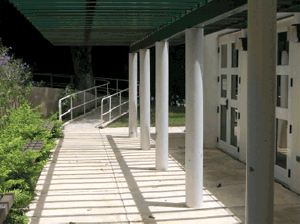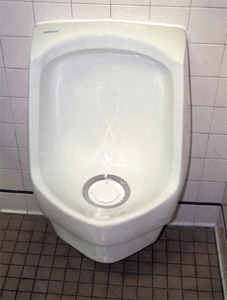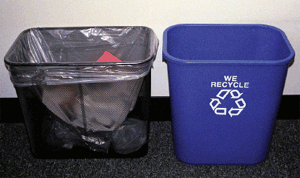Building Envelope
The building envelope consists of everything that separates the contents of the building from the weather. Improving the performance of the building envelope can save a bundle in energy costs.
The importance of adequate insulation in both hot and cold climates can hardly be overstated. Adding insulation to older buildings that don't meet current energy codes usually pays for itself quickly in buildings with significant heating or cooling costs. Adding blown-in or batt insulation to attic spaces and foam insulation to crawl space walls is usually inexpensive. Insulation immediately increases employee or resident comfort and reduces heating and cooling bills. When adding attic insulation, be sure to block out space to allow air to flow from roof eaves to ridge or gable vents so that you don't create a condensation problem.
When siding modifications become necessary, it may be cost effective to also add insulation to exterior walls. Adding insulation can affect moisture transfer through walls. Climates differ, so check with a knowledgeable engineer or architect for moisture control and insulation techniques that are appropriate for your area.
Building entrances can be big energy wasters. Frequently-used entrances in buildings that have significant heating or cooling requirements usually should have an "air lock" entry system consisting of inner and outer doors with several feet of space between them to limit the amount of conditioned air that escapes the building as people come and go. Adding a vestibule and porch or covered terrace to the main entrance of a building also can make the front entry more welcoming and easier for visitors to find.
Exterior doors can waste energy if they are not insulated or if they don't have good weather seals around the edges. Consider replacing older, uninsulated metal doors, especially if they are in poor condition. Add weather seals around any doors that don't have them. Generally, seals that are designed to compress when the door closes work better than other types.
Windows admit sunlight that can greatly reduce the need for expensive artificial lighting. They also let employees see outdoors, which is important for their well being and morale. However, windows can be big energy wasters. The single-pane aluminum and steel frame windows that were commonly installed in the mid 20th century are extremely good at transferring heat and cold between the indoor and outdoor environments—the opposite of energy efficiency. When they break or wear out, it is generally better to replace these windows rather than to repair them if the building interior is heated or cooled. Choose new windows with frames that minimize conduction of heat or cold between inside and outside to cut energy bills. Wood, vinyl, fiberglass, and aluminum frames with thermal breaks each have advantages and drawbacks.
Windows with low-emissivity coatings and an inert gas such as argon between the double panes are a good energy investment in harsh climates. Low-emissivity coatings reduce radiant heat transfer through the glass. Inert gases have a higher resistance to heat flow than does air. If solar heat gain or glare are problems, consider adding shade plants or devices outside the windows to block the heat and glare while still allowing filtered light to enter the building (figure 10).

Figure 10—Light filters through the overhanging trellis shading
the glass doors
of the conference room at the International
Institute of Tropical Forestry, a
Forest Service research
and technology transfer station in Puerto Rico.
Check with your unit archeologist or architectural historian before making a decision to replace windows on historically significant structures. Replacement of original windows may not be appropriate. Interestingly, restored wood windows in historic buildings combined with carefully crafted wood storm windows often perform nearly as well as the latest window models.
Adding skylights or light tubes also can reduce the need for artificial light. Light tubes are similar to skylights, but use a reflective tube to conduct light from the roof down into the room. While skylights can be difficult to install in an existing building, light tubes often can be installed relatively easily between existing roof trusses or joists.
Building MaterialsDuring maintenance work that requires demolition, remove materials carefully and use salvaged materials for repairs where practical. Doing so not only cuts down on landfill fees, but minimizes the difficulties of matching undisturbed materials and the costs of new materials. If reuse isn't possible, check to see whether a local business dealing in salvaged building materials will accept some or all of the materials you remove. Some drywall, ceiling tile, and carpet manufacturers will take salvaged materials back for reprocessing. Look on the back of the material for the manufacturer's name and give them a call to see whether they take their materials back.
- Check out the U.S. Environmental Protection Agency's WasteWise Web site (http://www.epa.gov/epawaste/partnerships/wastewise/index.htm), GSA's Construction Waste Management database (http://www.wbdg.org/tools/cwm.php), and The Forest Products Lab's Directory of Wood-Framed Building Deconstruction and Reused Building Materials Companies, 2005 (http://www.fpl.fs.fed.us/documnts/fplgtr/fpl_gtr150.pdf) for more information on reusing and recycling building components.
Siding and roofing materials come in such a variety that it's tempting to simply replace them in kind when the existing materials wear out. Instead, consider whether different materials might help cut energy use and whether it would be cost effective to use roofing or siding made from renewable, recycled, or recyclable materials. For instance, "cool roof" material that reflects ultraviolet radiation from the sun can decrease the amount of air-conditioning needed in buildings and reduce peak cooling demand by 10 to 15 percent. "Cool roofs" are available in recycled and recyclable materials such as steel or recycled rubber "slate" tiles.
- More information about cool roofs is available at the California Energy Commission's Consumer Energy Center Web site (http://www.consumerenergycenter.org/coolroof/).
When the membrane or built-up surface of a "flat" roof must be replaced, consider changing to a green roof. Green roofs consist of drought-resistant plants growing in lightweight soil on top of a waterproof membrane. Green roofs reduce storm water runoff rates by 40 to 75 percent, decrease the air conditioning costs attributable to heat transfer through the roof by up to 75 percent, lengthen roof membrane life by up to 50 percent, reduce noise transfer from outside the building, and decrease the urban "heat island" effect. Green roofs can be installed instead of ballast.
Modular green roof systems are available that weigh as little as 15 pounds per square foot even when fully saturated with rainwater. Lightweight modular green roofs are relatively expensive ($9 per square foot), so they are likely to be cost effective only where air conditioning or storm water disposal costs are high, or where rebates or incentives are available. The City of Seattle has estimated that the cost premium for a green roof over the 40-year life of the roof is only about 10 percent. Check with a structural engineer to make sure the building can support the weight of a green roof.
- More information about green roofs is available at
http://www.epa.gov/heatisld/mitigation/greenroofs.htm.
- More information about lightweight, modular green roofing systems is available at the Green Grid (http://www.greengridroofs.com/) and Green Tech (http://www.greentechitm.com/systems/roof.asp) Web sites.
When repainting or replacing wornout materials, check to see whether you can get natural materials (such as wool, jute, and coconut fiber) or materials with recycled content that meet your requirements for a similar price. Natural materials usually don't give off irritating fumes, so they can be better for employee health. Using materials with recycled content conserves nonrenewable resources.
For the best value over the product's complete life cycle, be sure to compare the material's durability, cleaning, and maintenance requirements. Whenever possible, use low volatile organic content (VOC) materials, particularly with materials such as sealants, adhesive, and paints.
- For assistance in choosing "green" materials, visit the Green Materials and Construction page of the Forest Service Engineering internal Web site at http://fsweb.wo.fs.fed.us/eng/programs/facilities/sus_green/greenmats.htm or the Environmental Protection Agency's Environmentally Preferable Purchasing Web site at http://www.epa.gov/epp/.
Water conservation can reduce utility bills substantially. In areas without a public water supply, using plumbing that conserves water means water systems can be smaller and will cost less to construct and operate.
Faucets and fixtures that use less water are the norm for new construction. Their effectiveness has improved dramatically from the days of low-flow toilets that required multiple flushes and flow-restricted shower heads that barely dribbled water. When older fixtures or faucets break or reach the end of their useful life, replace them with water-efficient fixtures. In areas where water costs are high or the water supply is limited, it may be cost effective to replace older fixtures and faucets that still work.
Most toilets manufactured before 1994 use 5 to 7 gallons per flush If you have older toilets in high-use areas, and your water costs are high or your water supply is limited, replacing them with new low-flow toilets will be cost effective.
There are differences in effectiveness among low-flow toilets. Pressure flush, dual flush, air assist, vacuum flush, and gravity models with 1.6-gallon flushes or ultralow flushes of less than 1 gallon are available in all price ranges. Studies have determined the models that work best. Surprisingly, cost does not necessarily indicate flushing effectiveness. Some of the most effective low-flow toilets cost about $100.
Waterless urinals don't flush. Instead, urine flows through a specially designed trap containing a fluid barrier that prevents sewer vapors from escaping into the restroom air. Urine sinks through the fluid barrier, overflows into the central tube, and runs down to the sewer line.
The urinals at MTDC (figure 11) are all waterless. About 60 employees work in the office/shop/laboratory building. The attached training center is used by outside groups of up to 200 people. The waterless urinals work well because staff and maintenance personnel are trained to use and maintain them properly. The eight waterless urinals save about 60,000 gallons of water each year.
- More information on low-flow toilets and waterless urinals is available at the Forest Service's internal Web site Water Conserving Fixtures and Products (http://fsweb.wo.fs.fed.us/eng/programs/facilities/sus_green/fix_pro.htm).

Figure 11—Waterless urinals work well if they are
used and maintained
properly. The six waterless urinals
at MTDC save about
60,000 gallons of water each year.
Another way to save water is to install new low-flow shower heads and faucet aerators. A flow of less than 2.5 gallons per minute is considered low flow for both sink faucets and shower heads. Flow rates usually are stamped on the side of sink faucet aerators, but you may have to measure the volume of water per minute in the shower using a pan or bucket. Low-flow faucet aerators usually cost $5 to $10. Lowflow shower heads cost from $8 to $50.
Faucets that are controlled by infrared sensors can save a lot of water—and the energy to heat the water—in heavily used restrooms. These faucets are common in public restrooms and have good public acceptance. In many areas, they experience less wear and vandalism than standard faucets. When replacing wornout sink faucets in heavily used restrooms, consider spending more for sensor-controlled faucets. Expect to pay at least $200. Photovoltaic-powered sensor faucets are available for $400 and up. Their sensors are powered by indoor lighting and eliminate the need for batteries or an electric connection.
Collecting RainwaterIf the structure is in an area with high water costs or a limited water supply, it may be cost effective to collect rainwater for use in plumbing systems. This is called rainwater harvesting. The least complex systems simply collect the water that comes off the roof, provide a way to separate dirt and debris, and use the water to irrigate the landscape.
More complex systems can be used for flushing toilets, fire protection, or even potable water. Complex systems usually require intricate plumbing and possibly a disinfection system. They aren't cost effective for existing structures except in unusual circumstances.
- More information about rainwater harvesting is available at Montana State University (http://water.montana.edu/pdfs/mt9707.pdf) and from the Texas Water Development Board (http://www.twdb.state.tx.us/publications/reports/rainwaterharvestingmanual_3rdedition.pdf).
Changing to sustainable cleaning products probably isn't going to have a significant effect on the operations budget, but it will improve indoor air quality and may help improve the productivity of employees, especially employees who are sensitive to chemicals.
Cleaning supplies that are less toxic and contain fewer volatile organic compounds are becoming increasingly common and are available from the GSA and in stores in most communities. In most cases, these products work as well as the standard products. The price premium is vanishing. As supplies are replaced and budgets allow, be sure that the products purchased are the least likely to have adverse affects on cleaning staff and building occupants.
- Information on environmentally preferable
cleaning products is available through the U.S. Environmental
Protection Agency (http://www.epa.gov/epp/pubs/products/cleaning.htm) and the U.S. General Services Administration Environmental Program (https://www.gsaadvantage.gov/advantage/search/specialCategory.do?cat=ADV.ENV).
- Executive Order 13101 sections 503 and 601 (http://www.ofee.gov/Resources/Guidance_reports/Guidance_reports_archives/greening.pdf) require Federal agencies to purchase environmentally preferable and biobased products when doing so is cost effective.
Recycling is the best known part of the waste reduction triangle—reduce, reuse, recycle (figure 12). Reducing means limiting the materials and supplies you purchase to the amount that is actually needed. Purchasing durable materials and supplies that can be washed, refilled, or refinished many times makes reuse more practical. Reducing, reusing, and recycling all reduce the amount of waste produced.

Figure 12—This familiar
logo was drawn by college
student Gary Anderson
for use during the first
Earth Day in 1970. Now
it's recognized worldwide
as the symbol of recycling,
recycled content, and
recyclable materials. The
mantra Reduce, Reuse,
Recycle is also associated
with the symbol.
Few administrative sites will make much money by selling recycled materials. However, administrative sites with garbage collection fees based on volume may save money by diverting recyclables from their waste stream. Recycling is a visible way of emphasizing that the Forest Service cares for the land, so it's important to recycle wherever practical. In most areas of the country, recycling services are available for a broad range of materials.
The best way to encourage recycling is to make it easy for people to "do the right thing" by providing convenient recycling containers (figure 13). Ideally, offices should have a paper recycling container beside each waste basket. Aluminum and plastic recycling containers should be provided near vending machines. Containers or storage areas for flattened cardboard should be located near the space where products or shipments are usually unboxed. Containers for newsprint, glass, and other recycled products should be near the places where these items are used. Return mailers for printer ink and copier toner cartridges should be located near the equipment.

Figure 13—Recycling paper is easier when there's a
recycling container
next to every wastebasket.
In most cases, it's more time and cost effective for a recycling collector to go around a building or site periodically collecting the contents of recycling containers than for each employee to haul materials to a central collection point. It's also more likely that people will recycle rather than throw recyclables away if recycling is easy and convenient.
Some materials that require regular replacement over the life of a building contain hazardous materials. For instance, fluorescent tubes and mercury vapor, metal halide, and highand low-pressure sodium lamps contain mercury; ballasts in old light fixtures may contain PCBs (polychlorinated biphenyls); and batteries may contain lead or cadmium. For these materials, recycling is not only the responsible thing to do but may avoid extra charges at the landfill for disposing of hazardous materials.
- More information about handling and disposing of these materials is available in the Hazmat in Buildings section of the Facilities Toolbox on the Forest Service's internal computer network at http://fsweb.mtdc.wo.fs.fed.us/toolbox/haz/haz16.htm.
This report has explained how small changes in operations practices and thoughtful maintenance choices can gradually improve the sustainability of Forest Service buildings and sites. Making cost-effective sustainability improvements also saves money. Keep this report where you can find it—it will continue to help you do well by your budget while doing good for the land.

Boundary Waters Canoe Area Wilderness, Superior National Forest.

